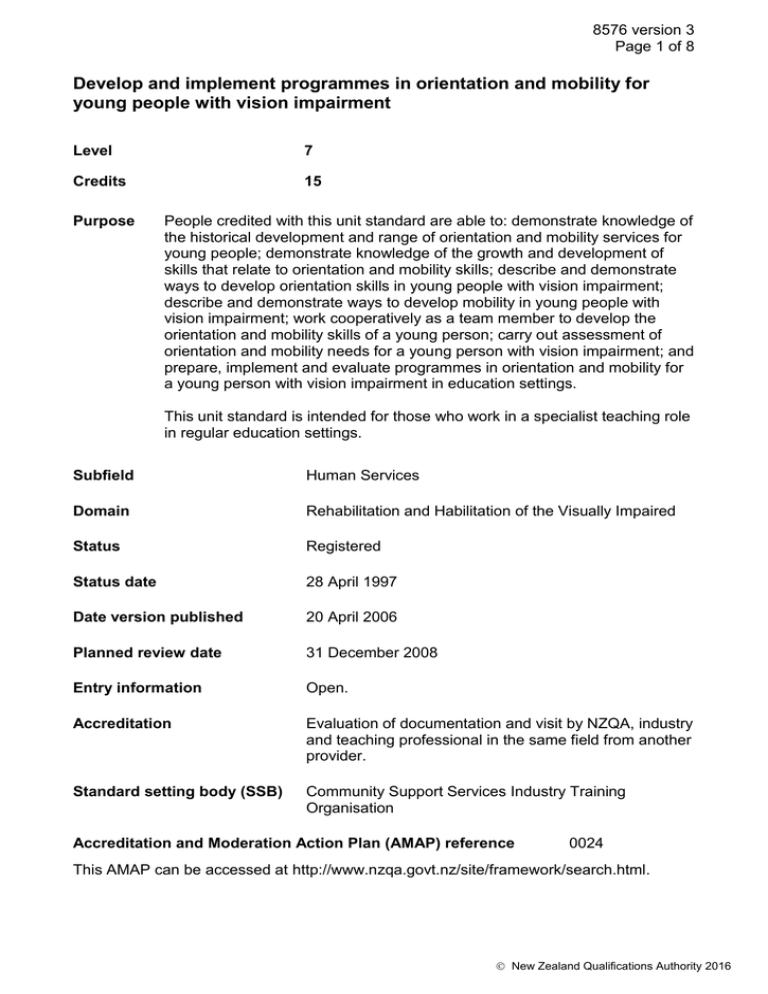Develop and implement programmes in orientation and mobility for
advertisement

8576 version 3 Page 1 of 8 Develop and implement programmes in orientation and mobility for young people with vision impairment Level 7 Credits 15 Purpose People credited with this unit standard are able to: demonstrate knowledge of the historical development and range of orientation and mobility services for young people; demonstrate knowledge of the growth and development of skills that relate to orientation and mobility skills; describe and demonstrate ways to develop orientation skills in young people with vision impairment; describe and demonstrate ways to develop mobility in young people with vision impairment; work cooperatively as a team member to develop the orientation and mobility skills of a young person; carry out assessment of orientation and mobility needs for a young person with vision impairment; and prepare, implement and evaluate programmes in orientation and mobility for a young person with vision impairment in education settings. This unit standard is intended for those who work in a specialist teaching role in regular education settings. Subfield Human Services Domain Rehabilitation and Habilitation of the Visually Impaired Status Registered Status date 28 April 1997 Date version published 20 April 2006 Planned review date 31 December 2008 Entry information Open. Accreditation Evaluation of documentation and visit by NZQA, industry and teaching professional in the same field from another provider. Standard setting body (SSB) Community Support Services Industry Training Organisation Accreditation and Moderation Action Plan (AMAP) reference 0024 This AMAP can be accessed at http://www.nzqa.govt.nz/site/framework/search.html. New Zealand Qualifications Authority 2016 8576 version 3 Page 2 of 8 Special notes 1 This unit standard is interpreted in accordance with: Health and Safety in Employment Act 1992. 2 Programmes in orientation and mobility are developed in consultation with specialists qualified in orientation and mobility for young people. 3 Glossary Vision impairment refers to a wide range of visual difficulties, which can be placed on a continuum that ranges from mild interferences in the visual system to total blindness; Orientation and mobility are interdependent skills. Orientation is the process of utilising sensory information to establish and maintain one’s position in the environment. Mobility is the process of moving safely, efficiently, and gracefully within one’s environment as independently as possible. In Scholl, G.T. Foundations of Education for Blind and Visually Handicapped Children and Youth, New York; American Foundation for the Blind, 1986; Young people refers to infants, toddlers and young children; children; and adolescents; Education literature refers to the information contained in research literature, which is recognised by the professional groups involved as meeting acceptable scientific standards; Current practice refers to practice that is recognised as highly acceptable by the professional groups involved; Individual plan is used in this document to include the following for young people with special needs: individual education plan, individual development plan, and individual transition plan; Parents is inclusive of other caregivers acting together with or on behalf of a parent. Elements and performance criteria Element 1 Demonstrate knowledge of the historical development and range of orientation and mobility services for young people. Performance criteria 1.1 The historical development of orientation and mobility services for young people is described in relation to international and national provisions. Range 1.2 examples are - development of adult services, extension of services to children. Orientation and mobility services for young people are identified in relation to current policies and provisions in New Zealand. New Zealand Qualifications Authority 2016 8576 version 3 Page 3 of 8 1.3 Roles of those who work with young people with orientation and mobility needs are determined. Range 1.4 orientation and mobility specialist, teacher, parent, teacher aide, young person, education support worker. Issues related to provision of orientation and mobility services for young people are identified. Range examples are - availability of child focused specialists, team approaches, provision of integrated programmes, philosophy of instructors, geographical distribution of young people, parent goals, funding. Element 2 Demonstrate knowledge of the growth and development of skills that relate to orientation and mobility skills. Performance criteria 2.1 Fine and gross motor development are defined in terms of their impact on orientation and mobility skills. 2.2 Developmental accomplishments in motor skills are described in general and in relation to variability that may be associated with young people who are vision impaired. 2.3 Strategies and activities that increase motor skills are described and demonstrated in accordance with current practice and education literature. Range examples are - motivational activities, play experiences. 2.4 Environmental awareness is described in relation to its importance for the development of orientation and mobility skills. 2.5 Strategies are identified and described that are associated with environmental concepts training. 2.6 Environmental features and adaptations are described in relation to supporting young people with a range of developmental levels to move about safely, confidently, efficiently and effectively. 2.7 The effects of complex needs are described in relation to the development of orientation and mobility behaviours. New Zealand Qualifications Authority 2016 8576 version 3 Page 4 of 8 Element 3 Describe and demonstrate ways to develop orientation skills in young people with vision impairment. Performance criteria 3.1 Sensory skills and their development are explained in relation to identifying, interpreting, and utilising environmental information for orientation and mobility. Range auditory, tactile, kinesthetic and proprioceptive, olfactory, vision skills. 3.2 Body image and spatial awareness and their development, are explained in relation to their role and use, to enhance purposeful movement in the environment. 3.3 Concept development is explained in terms of the effect on a child’s orientation abilities. 3.4 Procedures are demonstrated in relation to systematic search techniques and area familiarisation. Range 3.5 Procedures are demonstrated in relation to aiding straight line travel. Range 3.6 examples of procedures are - squaring off, parallel travel. Methods are outlined in relation to navigation and travel of young people with vision impairment. Range 3.7 examples of procedures are - concentric circle, perimeter, gridlines. examples of methods are - use of reference points, time and distance, soliciting aid. Common media and materials are identified and demonstrated in relation to their use to support orientation and mobility instruction for young people with vision impairment. Range examples of media and materials are - visual, tactile, auditory maps and models, graphic aids, tape recorded information. New Zealand Qualifications Authority 2016 8576 version 3 Page 5 of 8 Element 4 Describe and demonstrate ways to develop mobility in young people with vision impairment. Performance criteria 4.1 The use of a human guide is described in terms of purpose, techniques, environments, and teaching considerations, and is demonstrated. 4.2 Self-protection techniques are described and demonstrated in terms of purpose, techniques, environments, and teaching considerations. Range 4.3 Seating techniques are described in terms of increasing independence in mobility. Range 4.4 body protection, trailing. examples are - child chair, adult chair, car seat. The different types and use of mobility, optical, and electronic devices in relation to young people are explained in terms of their construction, maintenance, prescription and use. Range examples are - infant movement enhancers, toys, adapted devices, canes, trisensor, sonic guide, Mowat sensor, monocular. 4.5 Mobility and optical devices and techniques, and electronic travel aids are described and demonstrated in terms of independent travel. 4.6 Travel techniques are described in relation to indoor environments. Range 4.7 Travel techniques are described in relation to street travel. Range 4.8 examples are - stairs, hinged and revolving doors, lifts, escalators. examples are - footpath travel, street corners, crossing streets. Travel techniques are described in relation to particular areas. Range examples are - business districts, rural areas, car parks. Element 5 Work cooperatively as a team member to develop the orientation and mobility skills of a young person. Performance criteria 5.1 Parents, learning priorities, family situations, skills, and concerns are reflected as appropriate in the young person’s individual plan. New Zealand Qualifications Authority 2016 8576 version 3 Page 6 of 8 5.2 The young person is included as a team member in ways that reflect his or her skills, preferences, and developmental level. 5.3 Specialist and skilled personnel are consulted as appropriate in relation to education environment, assessment, programme preparation and implementation of formal orientation, and mobility skills. 5.4 Other adults and peers who work with a young person are included as appropriate through the individual education plan process in ways that ensure the programme of a young person is coordinated, integrated, functional, and provides consistent orientation and mobility input. Element 6 Carry out assessment of orientation and mobility needs for a young person with vision impairment. Performance criteria 6.1 Methods are described and appraised in relation to assessment of young people with orientation and mobility needs. Range 6.2 standardised assessment using published instruments, systematic observation in natural settings, assessment of environmental features that affect orientation and mobility, interviews. An assessment plan is prepared in consultation with others who work with the young person. Range orientation and mobility specialist, physiotherapist, occupational therapist teacher, parent, young person. 6.3 An assessment plan is prepared in which procedures are specified in relation to the specific needs of a young person with a vision impairment. 6.4 Assessment is carried out, and skills, difficulties, and possible contributing factors are identified. Element 7 Prepare programmes in orientation and mobility for young people with vision impairment in education settings. Range infant or toddler or young child; school age child. Performance criteria 7.1 A programme is prepared that is based on the assessment information and analysis, and reflects current practice. New Zealand Qualifications Authority 2016 8576 version 3 Page 7 of 8 7.2 A programme is prepared that is integrated with the young person’s individual education plan, and specifies procedures for implementation and integration with other areas. Range programme preparation includes but is not limited to goals, methods, environments, people, tasks and activities, adaptations, responsibilities, monitoring and evaluation systems, follow up. Element 8 Implement and evaluate programmes in orientation and mobility for young people with vision impairment in education settings. Range infant or toddler or young child; school age child. Performance criteria 8.1 The programme is implemented in accordance with a plan. 8.2 Procedures are implemented in accordance with current practice and the needs of the young person. 8.3 Procedures for generalisation of skills are implemented as appropriate. Range 8.4 examples of procedures are - generalisation across people, environments, time. The programme is monitored and evaluated in terms of its effectiveness for developing orientation and mobility skills. Please note Providers must be accredited by the Qualifications Authority, or an inter-institutional body with delegated authority for quality assurance, before they can report credits from assessment against unit standards or deliver courses of study leading to that assessment. Industry Training Organisations must be accredited by the Qualifications Authority before they can register credits from assessment against unit standards. Accredited providers and Industry Training Organisations assessing against unit standards must engage with the moderation system that applies to those standards. New Zealand Qualifications Authority 2016 8576 version 3 Page 8 of 8 Accreditation requirements and an outline of the moderation system that applies to this standard are outlined in the Accreditation and Moderation Action Plan (AMAP). The AMAP also includes useful information about special requirements for organisations wishing to develop education and training programmes, such as minimum qualifications for tutors and assessors, and special resource requirements. Comments on this unit standard Please contact the Community Support Services Industry Training Organisation enquiries@cssito.org.nz if you wish to suggest changes to the content of this unit standard. New Zealand Qualifications Authority 2016



